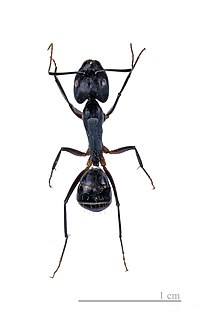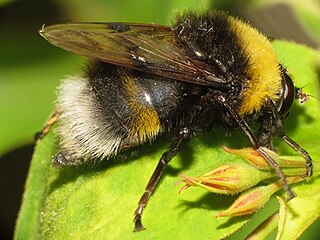 W
WAgelaia is a genus of Neotropical social wasps, with species from Mexico to northern Argentina. Fifteen of the 31 described species are found in Brazil. These species are swarm founders that nest in cavities. The nest generally is without an envelope.
 W
WThe Asian hornet, also known as the yellow-legged hornet or Asian predatory wasp, is a species of hornet indigenous to Southeast Asia. It is of concern as an invasive species in some other countries.
 W
WBacillus is a stick insect genus, common in Europe and North Africa.
 W
WThe Colletidae are a family of bees, and are often referred to collectively as plasterer bees or polyester bees, due to the method of smoothing the walls of their nest cells with secretions applied with their mouthparts; these secretions dry into a cellophane-like lining. The five subfamilies, 54 genera, and over 2000 species are all evidently solitary, though many nest in aggregations. Two of the subfamilies, Euryglossinae and Hylaeinae, lack the external pollen-carrying apparatus that otherwise characterizes most bees, and instead carry the pollen in their crops. These groups, and most genera in this family, have liquid or semiliquid pollen masses on which the larvae develop.
 W
WCrossocerus is a genus of square-headed wasps in the family Crabronidae. There are at least 250 described species in Crossocerus.
 W
WThe Formicinae are a subfamily within the Formicidae containing ants of moderate evolutionary development.
 W
WHaematobia is a genus of biting true flies of the family Muscidae.
 W
WLindenius is a genus of wasps in the family Crabronidae. Most species are found in the Palearctic a few are Nearctic.63 species are known
 W
WMelipona bicolor Lepeletier, 1836, commonly known as Guaraipo or Guarupu, is a eusocial bee found primarily in South America. It is an inhabitant of the Araucaria Forest and the Atlantic Rainforest, and is most commonly found from South to East Brazil, Bolivia, Argentina, and Paraguay. It prefers to nest close to the soil, in hollowed trunks or roots of trees. M. bicolor is a member of the tribe Meliponini, and is therefore a stingless bee. This species is unique among the stingless bees species because it is polygynous, which is rare for eusocial bees.
 W
WOrnidia is a small genus of small (2.3–4.2 mm) metallic hoverflies.
 W
WPlatycheirus is a large genus of hoverflies.
 W
WPocota is a genus hoverflies, from the family Syrphidae, in the order Diptera.
 W
WPonerinae is a subfamily of ants in the Poneromorph subfamilies group, with about 1,600 species in 47 extant genera, including Dinoponera gigantea - one of the world's largest species of ant. Mated workers have replaced the queen as the functional egg-layers in several species of ponerine ants. In such queenless species, the reproductive status of workers can only be determined through ovarian dissections. Ponerinae is a subfamily of ants within the family of Formicidae. These ants typically nest in soil, forest litter, or rotting logs, and are predacious. They primarily prey on isopods. They mostly live in small colonies of up to 200 workers. They can be found mostly in tropical environments, but have been found in southeastern Canada and New York. Female workers have twelve segmented antennae, whereas male workers have 13 segmented antennae.
 W
WPrisopus is a genus of stick insects belonging to the family Prisopodidae. These stick insects are present in America, India and Malesia.
 W
WProsena is a genus of flies in the family Tachinidae.
 W
WRopalidia marginata is an Old World species of paper wasp. It is primitively eusocial, not showing the same bias in brood care seen in other social insects with greater asymmetry in relatedness. The species employees a variety of colony founding strategies, sometimes with single founders and sometimes in groups of variable number. The queen does not use physical dominance to control workers; there is evidence of pheromones being used to suppress other female workers from overtaking queenship.
 W
WSphaerophoria is a genus of hoverflies.
 W
WSyritta is a genus of hoverflies, family Syrphidae.
 W
WTemnostoma is a genus of hoverflies. The larvae of some species feed on the wood of deciduous trees.